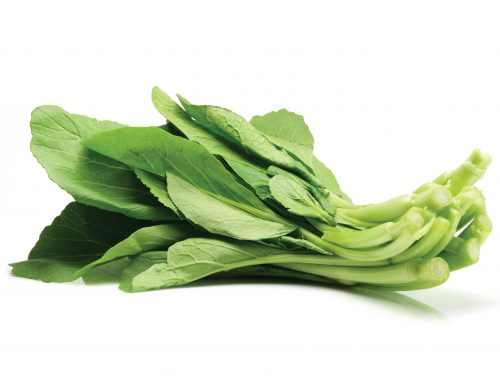
Choy sum
Choy sum, also known as Chinese flowering cabbage, is a popular Asian green. It is a good source of folate and vitamin B6, as well as beta-carotene, an antioxidant that can be converted to vitamin A in our bodies. Choy sum also provides fibre, calcium and iron.
With its lower levels of oxalic acid (which interferes with mineral absorption), the iron and calcium in choy sum and other Asian greens is more readily absorbed than from spinach or silver beet.
Sow choy sum from spring onwards, and pick as you need it. Choy sum has pale yellow flowers and is best picked before the flowers bloom.
Cook this vegetable similarly to broccoli, using quick cooking methods. Both the leaves and stems can be added to stir-fries, salads and soups, or eaten raw or steamed.
Recipe ideas
Chilli beef with cashews and greens
Choy sum, chicken and prawn noodle soup
Sage
While we generally only use small amounts of herbs such as sage in cooking, they do add small amounts of phytochemicals that can enhance our health. More than 160 antioxidant polyphenols have been found in sage, some of which are unique to the plant’s Salvia genus. Studies strongly suggest that diets rich in plant polyphenols can help protect us against developing chronic diseases, such as cancers, cardiovascular disease, diabetes, osteoporosis and neurodegenerative diseases.
The aromatic, almost spicy flavour of sage is strong and pairs well with poultry, pork and sausage as well as vegetables. It’s great in Italian-style dishes too.
Plant sage from spring onwards in full sun.
Recipe ideas
Tangy lemon chicken with crispy sage potatoes
Oven-baked pumpkin and sage risotto
Loquat
Low in kilojoules, loquats are a guava-like yellow fruit that add small amounts of a wide range of nutrients, including fibre and potassium. Five loquats provide around 1.4g fibre, important for bowel health, and around 200mg of potassium, important for maintaining healthy blood pressure.
Loquats are more likely to be found in Kiwi backyards rather than in the supermarket, and trees fruit during November and December. Eat the sweet fruit fresh off the tree, or make jam or preserves (leave a stone or two in to give it some bite). Loquats can also be made into liqueur and wine.
Did you know? Loquat trees can grow up to 8m tall and are sometimes viewed as weeds due to the large number of seeds they produce and the tree’s quick growth.
Fresh this month
(Harvested in New Zealand gardens in November)
Vegetables: Artichokes (globe), asparagus, avocado, beetroot, broad beans, broccoli, green cabbage, carrot, cauliflower, courgettes, cucumber, eggplant, fennel, garlic, lettuce, onions, parsnip, peas, potatoes, radish, rhubarb, silver beet, spinach, squash, swedes, watercress
Herbs: Basil, chives, coriander, dill, marjoram, mint, oregano, parsley, rosemary, thyme
Fruit: Blueberries, boysenberries, gooseberries, kiwifruit, navel oranges, strawberries, tangelos
Article sources and references
- Pandey KB & Rizvi SI. 2009. Plant polyphenols as dietary antioxidants in human health and disease Oxidative Medicine and Cellular Longevity 2: 270-8https://www.ncbi.nlm.nih.gov/pmc/articles/PMC2835915/
www.healthyfood.com










